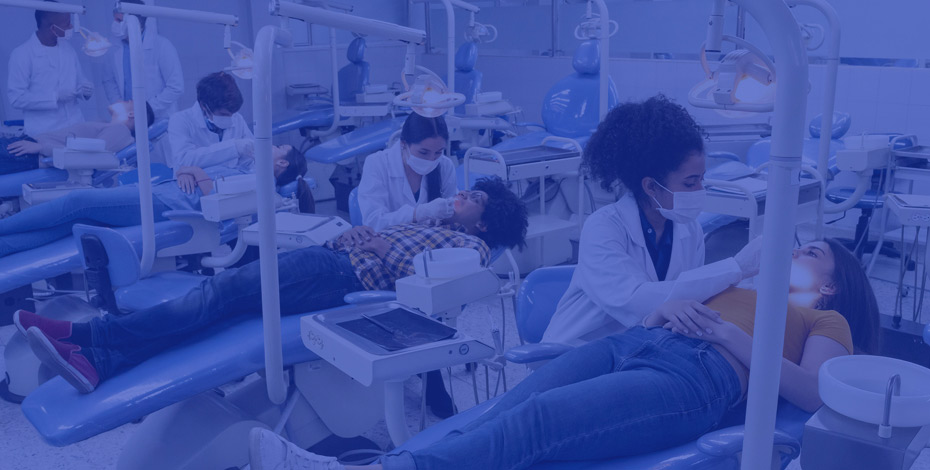Schools of dentistry and dental hygiene serve the important role of educating future dental professionals in the biomedical, clinical, and behavioral sciences. These schools equip students with the cognitive skills required to diagnose and treat patients and the clinical skills needed to effectively perform a wide variety of oral procedures.
From preparing students for National Board Dental Examinations (NBDE) to maintaining educational requirements set forth by the Commission on Dental Accreditation (CODA), dental programs work to cultivate an environment of learning that upholds the highest standards of dental medicine.
With ExamSoft’s all-in-one solution, dental schools have access to the tools they need to deliver secure and reliable assessments, all while increasing student retention, improving board exam passage rates, streamlining the accreditation process, and more.
Learn about the top benefits of implementing our platform in dental education programs:
- Question Types and Tools for NBDE Prep
- Clinical Competency Scoring with ExamSCORE
- Item Mapping to Dental Accreditation Standards
- Performance Reports for Improved Student Outcomes
- Exam and Item Quality Analysis with Psychometrics
- Flexible Options for Exam Security in Any Setting
Question Types and Tools for NBDE Prep
When creating summative exams, dental educators start by ensuring that assessment material meets the immediate requirements of the course. But educators can also use their assessments to begin preparing students for board exams, including the Integrated National Board Dental Examination (INBDE) and National Board Dental Hygiene Examination (NBDHE).
By choosing exam formats consistent with those proposed by the Joint Commission on National Board Examination, educators can help dental students become familiar with certain assessment modes so that they can better exercise their cognitive skills on exam day.
ExamSoft’s question types and assessment tools allow dental educators to mirror the multiple-choice format of the INBDE and NBDHE in their own assessments. With options for including supplemental material such as images and video attachments on individual exam items, educators can provide patient information, dental x-rays, and clinical evaluation charts to supplement the exam-taker’s understanding of a given question.
Clinical Competency Scoring with ExamSCORE
Assessing clinical knowledge is an essential aspect of dental education that contributes to student success post-graduation. Whether live or simulated, clinical evaluations introduce students to a range of scenarios common in their field and prepare them for state clinical examinations required to obtain dental licensure.
With ExamSCORE, ExamSoft’s rubric-based grading tool, dental programs can streamline the clinical exam process to increase efficiency for both students and faculty. In 2014, the College of Dental Medicine at Western University of Health Sciences did just that, using ExamSCORE to transition from paper-based to electronic grading in their college-operated dental clinic.
The College of Dental Medicine found that it was able to quickly create rubrics within the ExamSoft portal, instantly score performance in clinical cases, and release results to students in less than half the time of their paper-based system. The college also used ExamSCORE to create and grade practice board exams for their graduating seniors, including a mock endodontics exam for the Western Regional Examining Board (WREB).
Item Mapping to Dental Accreditation Standards
While it can be difficult to know where to begin when preparing for an upcoming accreditation visit, it’s important develop a reliable system for demonstrating continued adherence to accreditation criteria.
As building blocks of course curricula, assessment items can reliably measure exam-takers’ understanding of required course material. By tagging individual items to specific educational standards and learning objectives, faculty can determine which areas their courses are covering, identify any gaps in content, and make curricular adjustments as necessary.
With Map, ExamSoft’s curriculum mapping tool, dental schools can associate exam items and rubric criteria to categories based on CODA standards and create a visual representation of accreditation criteria from exam item to course, course to program, and program to college. With the click of a button, faculty can generate these category-driven reports for use during accreditation visits. Plus, Map’s archive feature makes it easy to evidence any improvements to the curriculum over time.
Performance Reports for Improved Student Outcomes
Tagging exam items by category is not only useful for demonstrating adherence to accreditation standards and programmatic learning objectives, it can also give dental educators the insights they need to provide timely feedback and remediation to keep students on the path to graduation.
With ExamSoft’s Strength & Opportunity Reports, dental instructors can create individualized student reports that break down performance by categories tagged to their exam items. By identifying specific areas of the curriculum where a student is struggling and excelling, instructors can provide targeted remediation for directing effective study habits. And, with ExamSoft’s longitudinal reporting tools, instructors can easily determine if students are improving in certain areas over time.
These individualized feedback efforts can bear significant returns for the overall value of a dental program, resulting in a higher performing cohort, a higher student retention rate, and reduction in tuition dollars lost.
Exam and Item Quality Analysis with Psychometrics
If an assessment is to demonstrate compliance with accreditation criteria or effectively prepare students for NBDE or state clinical exams, its quality should also be evident in the results of psychometric analysis.
With a series of metrics, including item difficulty index, discrimination index, and point bi-serial, educators can determine whether exam items are the appropriate level of difficulty and whether the overall exam is a reliable measure of student knowledge.
In an effort to identify best practices for teaching and assessment, Tufts University School of Dental Medicine leveraged psychometric reports to analyze exams in its programs. The school was able to explore variances in student performance using point bi-serials and discovered opportunities for improving individual exam items and adjusting instruction methods to better foster student learning in certain areas of the curriculum.
Flexible Options for Exam Security in Any Setting
Now more than ever, dental schools need a secure assessment solution that they can rely on to deliver formative, summative, and clinical competency exams, both on campus and off.
Unlike web-dependent assessment solutions, ExamSoft’s platform does not require an internet connection during exam sessions, eliminating interruptions due to weak connectivity. In an off-campus testing environment, ExamSoft uses complete device control to disable access to anything beyond the exam file in order to protect exam integrity.
ExamID and ExamMonitor — ExamSoft’s auto-identity verification tool and A.I.-powered remote proctoring software — combine to provide unparalleled exam security in remote assessment. With these solutions, programs have the flexibility to toggle between modes of assessment as needed without compromising exam security.
All-in-One Assessment Software for Dental Schools
Request a demo to learn how ExamSoft can promote the overall success of your dental education programs.
Sources:
ExamSoft Webinar: Transitioning from Paper to Electronic Clinical Grading
ExamSoft Case Study: Tufts University School of Dental Medicine






